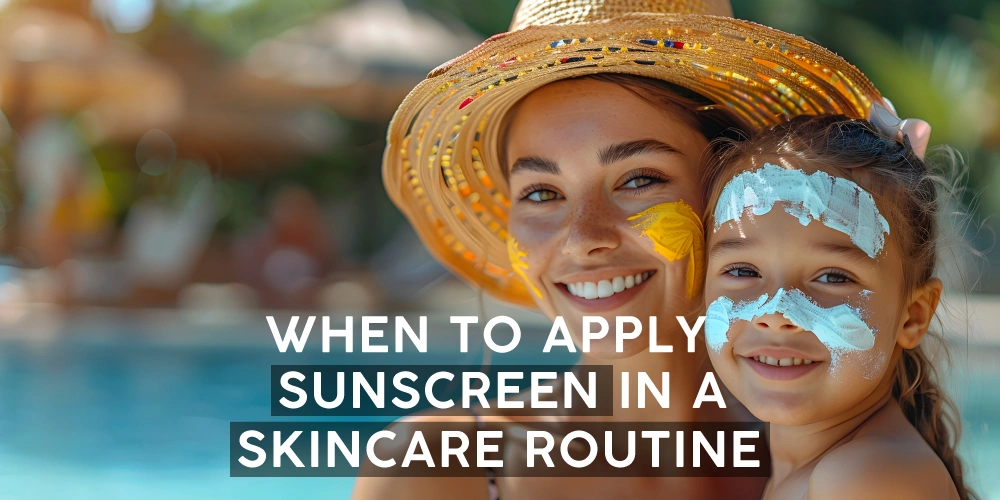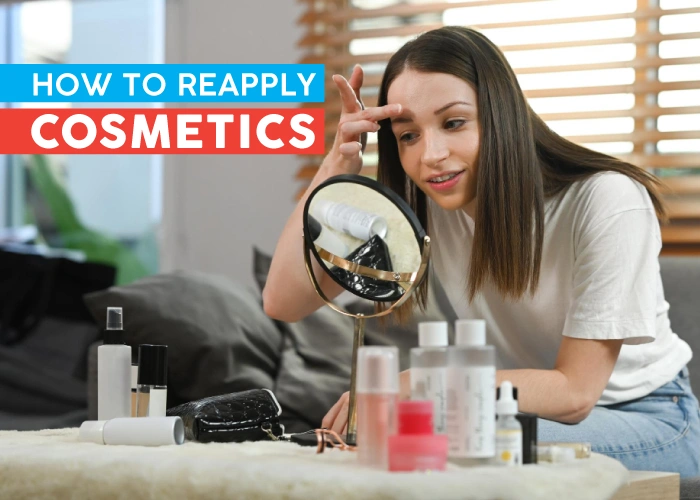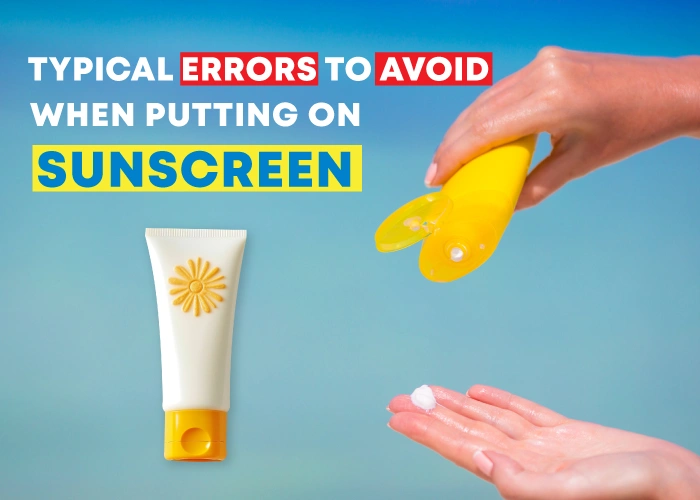One of the most critical components of any skincare regimen is sunscreen. It lowers the risk of skin cancer, delays the aging process, and shields your skin from damaging UV radiation. But many folks need to learn how to use sunscreen in their skincare routine. Here’s a guide to helping you decide when to apply sunscreen to get the most out of it and protect your skin. Let’s talk about When to use sunscreen in a skincare routine.
What Distinguishes Sunscreen from Moisturiser?
Sunscreen helps shield the skin from ultraviolet (UV) radiation, while moisturizer is intended to moisten the skin. This is the main distinction between the two products.
The Skin Cancer Foundation states that sunscreen is made with active chemicals that work to shield your skin from UV rays. This is crucial since UV radiation exposure can cause burns, hasten the aging process of the skin, and even worse conditions like skin cancer. On the other hand, frequent use of sunscreen can help avert these issues. Meanwhile, moisturizers support skin renewal and nourishment. Depending on the formula, they also aid in addressing obvious skin issues, including wrinkles, dark spots, and fine lines. Despite their different purposes, regardless of your skin type or problems, sunscreen and moisturizer should be a part of your daily skincare routine.
Why Is Sunscreen Such a Big Deal?
When used correctly, sunscreen helps shield your skin from UV radiation, which can cause burns, photoaging, and skin cancer. Using a broad-spectrum sunscreen with an SPF of 30 or higher is advised by the US Food and Drug Administration (FDA) and should be done every day, rain or shine. In addition, they recommend avoiding the sun between 10 a.m. and 2 p.m., wearing long sleeves and wide-brimmed hats, and reapplying sunscreen every two hours. The FDA advises applying roughly one ounce, or a shot glass full, of sunscreen to your entire body. This corresponds to using half a teaspoon on your neck and face.
The final step in your morning skincare routine should be applying sunscreen.
You should always finish your morning skincare routine with sunscreen. This is the reason why:
Protection Barrier: Sunscreen shields your skin from damaging UV radiation by forming a protective layer. Applying makeup, serums, or moisturizers after sunscreen puts it in danger of being diluted and losing its efficacy.
Optimal Absorption: For sunscreen to be effective, the skin must absorb it. By using it last, you can ensure it covers the skin’s surface uniformly and consistently.
Use Following Moisturiser
Why After Moisturiser? Moisturiser is intended to permeate the skin’s surface and provide the skin with hydration and nourishment. In contrast, sunscreen is designed to produce a protective layer on top of your skin. When moisturizer is used after sunscreen, it can break down that barrier and lessen the UV protection of the sunscreen.
How to Submit an Application After using your moisturizer, let it take one to two minutes to sink into your skin completely. Next, evenly apply a thick layer of sunscreen to your neck and any exposed face areas.
Hold Off on Putting on Cosmetics
Wait Time: Give your sunscreen two to three minutes to set before wearing makeup. This keeps the sunscreen intact and helps avoid pilling, which is the formation of tiny flakes or balls on the skin caused by improper adhesion between product layers. This results in the best possible protection for the skin.
Applying a Primer: Give your primer time to set after applying sunscreen if you plan to use one before makeup.
Reapply Throughout the Day Frequency:
If you spend much time outside or in the sun, you should reapply sunscreen every two to three hours. It is usually adequate to reapply every 4-6 hours if you are indoors and away from windows.
How to Reapply Cosmetics:
Choose a powder or spray form to reapply sunscreen over makeup without affecting your appearance. Applying a thin, transparent powder or spritzing sunscreen on your face can protect you without sacrificing your makeup.
Using Sunscreen with Additional Active Substances Retinol:
Because it can make your skin more sensitive to the sun, use retinol and other exfoliating or potent actives (such as AHAs and BHAs) only at night. Use sunscreen in the morning to keep your skin safe.
Vitamin C One powerful antioxidant that increases the efficacy of sunscreen is vitamin C. Please wear it before your sunscreen and moisturizer to improve defense against UV rays and free radical damage.
Sunscreen Types and How They Affect Application Chemical sunscreens:
These include UV-absorbing active compounds such as oxybenzone and avobenzone. They should be applied at least 15 to 20 minutes before being in the sun to give them time to absorb.
Physical (Mineral) Sunscreens: These have active components on top of the skin and reflect UV light, such as titanium dioxide or zinc oxide. Applying them will make them work instantly, so you don’t have to wait to go outside.
Take Into Account the Sunscreen Type for Applying Makeup: Lightweight Sunscreens:
These look well under makeup, especially on oily face types. To prevent blocked pores and a greasy finish, look for non-comedogenic and oil-free solutions.
Tinted sunscreens offer light coverage and skin protection simultaneously, making them a great alternative to foundation or BB cream. They can help you avoid piling on too many products on top of your sunscreen and streamline your process.
Typical Errors to Avoid When Putting on Sunscreen:
Not Applying Enough
Most folks don’t use enough sunscreen. It would help if you had a shot glass full for your complete body and roughly the size of a nickel for your face.
Ignoring Some Areas:
Pay attention to regions such as the ears, neck, and eye. Despite being frequently disregarded, these areas are particularly vulnerable to solar damage.
Sunscreen Application Just Once:
Reapplying sunscreen is advised throughout the day, mainly if you sweat, swim, or spend much time in the sun. Applying It Right Before Apply sunscreen 15 to 20 minutes before going outside. This will give it time to set and provide a solid protective layer, mainly if it contains chemicals.
Is It Okay to Combine Sunscreen and Moisturiser?
While it seems like the ideal solution to the first issue of SPF vs. moisturizer, combining sunscreen and moisturizer into one holy grail product isn’t the case. When moisturizer and sunscreen are combined to create a hybrid mixture, formulae may not function as tested and, consequently, as intended. You want to avoid taking that chance when using sun protection.
But if you’d instead multitask, there’s an answer: SPF-containing moisturizer. This moisturizer is designed to hydrate your skin and shield it from the sun’s damaging UV rays. These can be a fantastic supplement to your everyday sunscreen regimen, but they shouldn’t take its place entirely.
In summary
Apply sunscreen as the final step in your daily skincare routine, after moisturizing but before makeup, to get the most benefit. To ensure ongoing protection, wait a few minutes before putting on makeup, and remember to reapply throughout the day. You can maintain your skin’s health, youthful appearance, and protection from the sun’s harmful rays by prioritizing sunscreen use in your skincare routine. Remember that long-term skin beauty depends on regular application of sunscreen!




